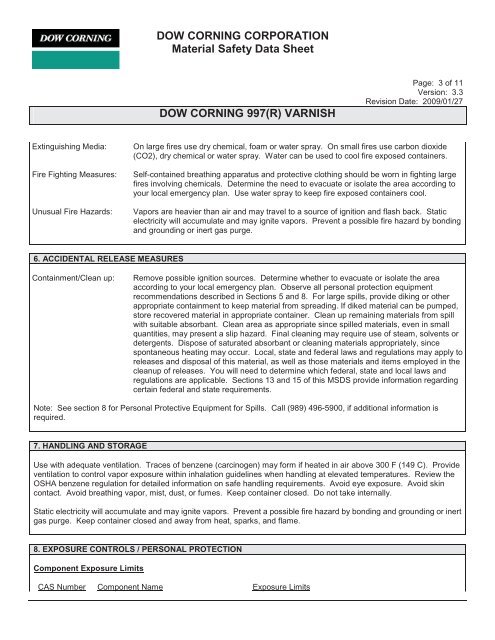Print MSDS - Miller Electric Company Publications
Print MSDS - Miller Electric Company Publications
Print MSDS - Miller Electric Company Publications
You also want an ePaper? Increase the reach of your titles
YUMPU automatically turns print PDFs into web optimized ePapers that Google loves.
DOW CORNING CORPORATION<br />
Material Safety Data Sheet<br />
DOW CORNING 997(R) VARNISH<br />
Page: 3 of 11<br />
Version: 3.3<br />
Revision Date: 2009/01/27<br />
Extinguishing Media: On large fires use dry chemical, foam or water spray. On small fires use carbon dioxide<br />
(CO2), dry chemical or water spray. Water can be used to cool fire exposed containers.<br />
Fire Fighting Measures: Self-contained breathing apparatus and protective clothing should be worn in fighting large<br />
fires involving chemicals. Determine the need to evacuate or isolate the area according to<br />
your local emergency plan. Use water spray to keep fire exposed containers cool.<br />
Unusual Fire Hazards: Vapors are heavier than air and may travel to a source of ignition and flash back. Static<br />
electricity will accumulate and may ignite vapors. Prevent a possible fire hazard by bonding<br />
and grounding or inert gas purge.<br />
6. ACCIDENTAL RELEASE MEASURES<br />
Containment/Clean up: Remove possible ignition sources. Determine whether to evacuate or isolate the area<br />
according to your local emergency plan. Observe all personal protection equipment<br />
recommendations described in Sections 5 and 8. For large spills, provide diking or other<br />
appropriate containment to keep material from spreading. If diked material can be pumped,<br />
store recovered material in appropriate container. Clean up remaining materials from spill<br />
with suitable absorbant. Clean area as appropriate since spilled materials, even in small<br />
quantities, may present a slip hazard. Final cleaning may require use of steam, solvents or<br />
detergents. Dispose of saturated absorbant or cleaning materials appropriately, since<br />
spontaneous heating may occur. Local, state and federal laws and regulations may apply to<br />
releases and disposal of this material, as well as those materials and items employed in the<br />
cleanup of releases. You will need to determine which federal, state and local laws and<br />
regulations are applicable. Sections 13 and 15 of this <strong>MSDS</strong> provide information regarding<br />
certain federal and state requirements.<br />
Note: See section 8 for Personal Protective Equipment for Spills. Call (989) 496-5900, if additional information is<br />
required.<br />
7. HANDLING AND STORAGE<br />
Use with adequate ventilation. Traces of benzene (carcinogen) may form if heated in air above 300 F (149 C). Provide<br />
ventilation to control vapor exposure within inhalation guidelines when handling at elevated temperatures. Review the<br />
OSHA benzene regulation for detailed information on safe handling requirements. Avoid eye exposure. Avoid skin<br />
contact. Avoid breathing vapor, mist, dust, or fumes. Keep container closed. Do not take internally.<br />
Static electricity will accumulate and may ignite vapors. Prevent a possible fire hazard by bonding and grounding or inert<br />
gas purge. Keep container closed and away from heat, sparks, and flame.<br />
8. EXPOSURE CONTROLS / PERSONAL PROTECTION<br />
Component Exposure Limits<br />
CAS Number Component Name Exposure Limits



